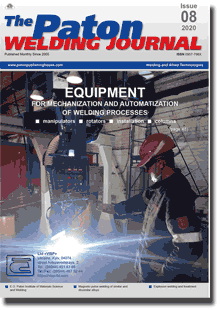| 2020 №08 (04) |
DOI of Article 10.37434/tpwj2020.08.05 |
2020 №08 (06) |

The Paton Welding Journal, 2020, #8, 29-33 pages
Improvement of service properties of metal structures by explosion treatment
A.G. Bryzgalin, E.D. Pekar, P.S. Shlonskiy and L.V. Tsarenko
E.O. Paton Electric Welding Institute of the NAS of Ukraine 11 Kazymyr Malevych Str., 03150, Kyiv, Ukraine. E-mail: office@paton.kiev.ua
Abstract
Explosion treatment of metals in the modern sense is represented by different technological processes based on application of the energy of explosion, and allowing improvement of certain service properties of the metals or welded structures. PWI developed technologies of explosion treatment to improve the corrosion resistance, dimensional stability, cyclic fatigue life of welded structures, lower the residual stresses, eliminate defects of tank shape, and increase the strength, ductility, and cold resistance of low-carbon steels. The above technologies have high mobility and responsiveness, and are independent of the external energy sources. Their disadvantage is limited applicability of explosion in settlements and long-term process of obtaining permits. However, there is extensive experience of application of explosion treatment under the conditions of operating industrial production. 15 Ref., 6 Figures.
Keywords: explosion treatment, welded structures, service properties, corrosion resistance, strength, ductility, fatigue life
Received 11.02.2020
References
1. Rainhart, J.S., Pierson, J. (1966) Explosive working of metals. Moscow, Mir [in Russian].2. Krupin, A.V., Soloviov, V.Ya., Popov, G.S. (1991) Explosion treatment of metals. Moscow, Metallurgiya [in Russian].
3. Mikheev, P.P., Trufyakov,V.I., Bushtedt, Yu.P. (1967) Application of pulsed treatment for improvement of reliability of welded joints. Avtomatich. Svarka, 10, 63–64 [in Russian].
4. Dobrushin, L.D., Petushkov, V.G., Bryzgalin, A.G. et al. (2008) Explosion stress relieving in welded joints of metal structures. Shock-Assisted Materials Synthesis and Processing. Science, Innovations and Industrial Implementation. Moscow, Torus Press Ltd.
5. Petushkov, V.G. (2005) Application of explosion in welding technology. Kiev, Naukova Dumka [in Russian].
6. Steklov, O.I. (2005) Strength of welded structures in aggressive media. Moscow, Mashinostroenie [in Russian].
7. Lobanov, L.M., Dobrushin, L.D., Bryzgalin, A.G. et al. (2009) Widening of technological capabilities of explosion treatment for reducing residual stresses in welded joints on up to 5000 m3 decomposers. The Paton Welding J., 11, 46-48.
8. Petushkov, V.G., Bryzgalin, A.G. (1997) Improvement of service properties of welded structures by explosion treatment. Welding and Surfacing Rev., 8, 167–175.
9. Kudinov, V.M., Petushkov, V.G. (1985) Resistance to corrosion cracking of welded joints treated by explosion. Svarochn. Proizvodstvo, 7, 1–4 [in Russian].
10. Artemiev, V.I., Pashchin, A.N., Petushkov, V.G. et al. (1978) Application of explosion energy for improvement of corrosion resistance of welded joints of decomposers. Tsvetnaya Metallurgiya, 5, 7–40 [in Russian].
11. Petushkov, V.G., Titov, V.A., Fadeenko, Yu.I. et al. (1988) Method of explosion treatment of welded joints. USSR author’s cert. 1453762 [in Russian].
12. Petushkov, V.G., Pervoj, V.M., Titov, V.A. et al. (1991) Method of reducing of angular residual deformations of welded joints. USSR author’s cert. 1700873 [in Russian].
13. Petushkov, V.G., Bryzgalin, A.G., Lokshina, E.Ya. et al. (1992) Method of manufacture of welded metal structures. USSR author’s cert. 1760713 [in Russian].
14. Petushkov, V.G., Fadeenko, Yu.I., Smirnova, S.N. et al. (1988) Explosion treatment of low-carbon steel welded joints before their heat treatment. Avtomatich. Svarka, 7, 68–69 [in Russian].
15. Petushkov, V.G., Titov, V.A., Bryzgalin, A.G. (2002) Limiting thickness of welded joints to be explosion treated. The Paton Welding J., 1, 20–26.
